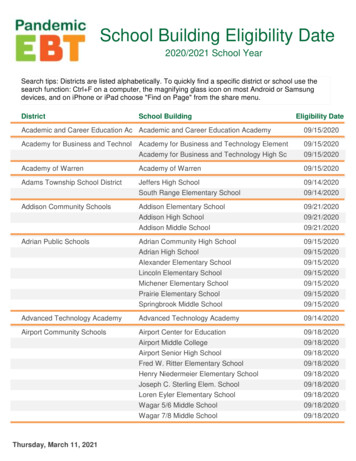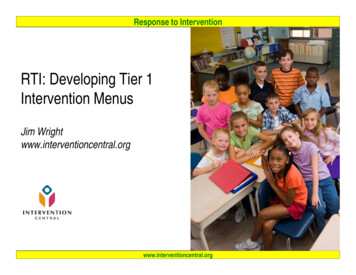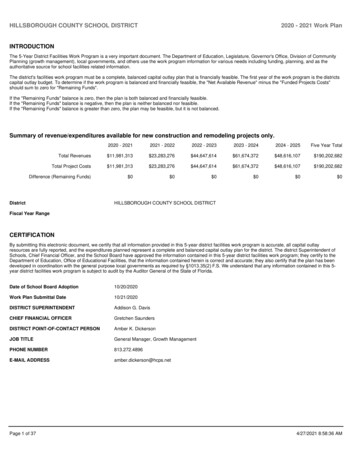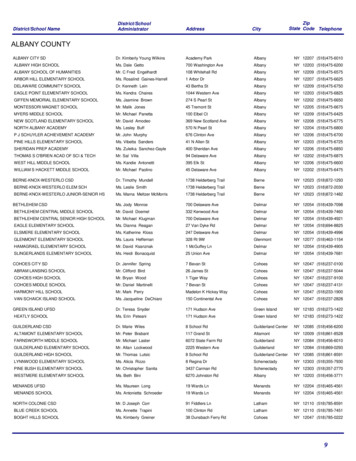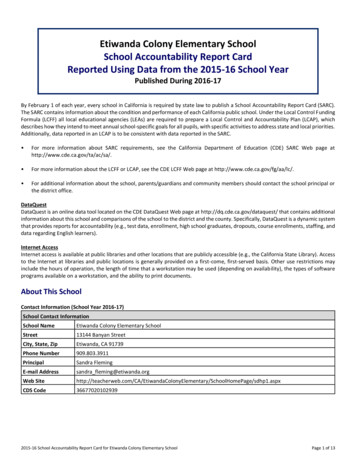
Transcription
Etiwanda Colony Elementary SchoolSchool Accountability Report CardReported Using Data from the 2015-16 School YearPublished During 2016-17By February 1 of each year, every school in California is required by state law to publish a School Accountability Report Card (SARC).The SARC contains information about the condition and performance of each California public school. Under the Local Control FundingFormula (LCFF) all local educational agencies (LEAs) are required to prepare a Local Control and Accountability Plan (LCAP), whichdescribes how they intend to meet annual school-specific goals for all pupils, with specific activities to address state and local priorities.Additionally, data reported in an LCAP is to be consistent with data reported in the SARC. For more information about SARC requirements, see the California Department of Education (CDE) SARC Web page athttp://www.cde.ca.gov/ta/ac/sa/. For more information about the LCFF or LCAP, see the CDE LCFF Web page at http://www.cde.ca.gov/fg/aa/lc/. For additional information about the school, parents/guardians and community members should contact the school principal orthe district office.DataQuestDataQuest is an online data tool located on the CDE DataQuest Web page at http://dq.cde.ca.gov/dataquest/ that contains additionalinformation about this school and comparisons of the school to the district and the county. Specifically, DataQuest is a dynamic systemthat provides reports for accountability (e.g., test data, enrollment, high school graduates, dropouts, course enrollments, staffing, anddata regarding English learners).Internet AccessInternet access is available at public libraries and other locations that are publicly accessible (e.g., the California State Library). Accessto the Internet at libraries and public locations is generally provided on a first-come, first-served basis. Other use restrictions mayinclude the hours of operation, the length of time that a workstation may be used (depending on availability), the types of softwareprograms available on a workstation, and the ability to print documents.About This SchoolContact Information (School Year 2016-17)School Contact InformationSchool Name-------Etiwanda Colony Elementary SchoolStreet-------13144 Banyan StreetCity, State, Zip-------Etiwanda, CA 91739Phone Number------- 909.803.3911Principal-------Sandra FlemingE-mail Address------- sandra fleming@etiwanda.orgWeb Elementary/SchoolHomePage/sdhp1.aspxCDS Code366770201029392015-16 School Accountability Report Card for Etiwanda Colony Elementary SchoolPage 1 of 13
District Contact InformationDistrict Name-------Etiwanda School DistrictPhone Number------- 909.899.2451Superintendent------ Shawn Judson, Ed.D.-E-mail Address------- shawn judson@etiwanda.orgWeb Site-------www.etiwanda.orgSchool Description and Mission Statement (School Year 2016-17)SCHOOL MISSIONThe staff of Etiwanda Colony Elementary School is committed to providing a quality education with an emphasis on academic successand student self-esteem. We aim to provide all students with a positive, safe, orderly, and challenging learning environment thatempowers them to become responsible and productive citizens.DISTRICT & SCHOOL PROFILEEtiwanda School District serves over 14,000 TK-8 students residing in the cities of Rancho Cucamonga, Fontana, Alta Loma, andEtiwanda. The district currently operates twelve TK-5 elementary schools and four middle schools (grades 6-8) and a Community DaySchool. Etiwanda’s graduating eighth grade students are served by Chaffey Joint Union High School District for grades 9-12. Homeschooling program, preschool program, and day care are provided at some schools within the district. More information about theseprograms may be acquired through the district’s web site or by contacting the district office at (909) 899-2451.The district’s commitment to excellence is achieved through a team of professionals dedicated to delivering a challenging, high qualityeducational program. Etiwanda School District appreciates the outstanding reputation it has achieved in local and neighboringcommunities. Consistent success in meeting student performance goals is directly attributed to the district’s energetic teaching staffand strong parent and community support.Etiwanda Colony is located in the heart of the Etiwanda community. Deriving its name from the original “Etiwanda Colony” Lands, thelocation was historically an agricultural area of citrus and stone fruits, and frequented by sheep herders. Now part of the rapidlygrowing city of Rancho Cucamonga, Etiwanda Colony serves students from the Summit Heights development in Fontana, to theneighborhoods in Rancho Cucamonga east of Etiwanda Avenue, and from the 210 freeway to the foothills of the local mountains.Etiwanda Colony first opened its doors to kindergarten through fifth grade students in the 2004-2005 school year. Outstanding andexperienced staff, dedicated students, and an involved, supportive parent partnership ensure that Etiwanda Colony’s Cubs are “ThePride of Etiwanda.”District-sponsored, fee-based child care is available Monday through Friday for Etiwanda Colony Elementary school-age students. Theday care center is open from 6:30 a.m. to 6:00 p.m. Participating students are provided enrichment activities in art, music, literature,and physical education. More information about the day care program may be obtained from the district’s web site or school officestaff.Student Enrollment by Grade Level (School Year 2015-16)GradeLevelNumber ofStudentsKindergarten149Grade 1124Grade 2127Grade 3157Grade 4161Grade 5152Total Enrollment8702015-16 School Accountability Report Card for Etiwanda Colony Elementary SchoolPage 2 of 13
Student Enrollment by Group (School Year 2015-16)StudentGroupPercent ofTotal EnrollmentBlack or African American8.5American Indian or Alaska Native0.3Asian7.7Filipino4Hispanic or Latino42.9Native Hawaiian or Pacific Islander0.1White32.1Two or More Races3.3Socioeconomically Disadvantaged25.2English Learners9.4Students with Disabilities15.2Foster Youth0.2A. Conditions of LearningState Priority: BasicThe SARC provides the following information relevant to the Basic State Priority (Priority 1): Degree to which teachers are appropriately assigned and fully credentialed in the subject area and for the pupils they areteaching; Pupils have access to standards-aligned instructional materials; and School facilities are maintained in good repair.Teacher 6-17With Full Credential4140.2515Without Full Credential001Teaching Outside Subject Area of Competence (with full credential)0002016-17Teacher Misassignments and Vacant Teacher nts of Teachers of English Learners000Total Teacher Misassignments *000Vacant Teacher Positions000Note: “Misassignments” refers to the number of positions filled by teachers who lack legal authorization to teach that grade level, subject area, student group, etc.* Total Teacher Misassignments includes the number of Misassignments of Teachers of English Learners.Core Academic Classes Taught by Highly Qualified Teachers (School Year 2015-16)Location of ClassesPercent of Classes In Core Academic SubjectsTaught by Highly Qualified TeachersNot Taught by Highly Qualified TeachersThis School100.00.0All Schools in District100.00.0High-Poverty Schools in District100.00.0Low-Poverty Schools in District100.00.0Note: High-poverty schools are defined as those schools with student eligibility of approximately 40 percent or more in the free and reduced price meals program.Low-poverty schools are those with student eligibility of approximately 39 percent or less in the free and reduced price meals program.2015-16 School Accountability Report Card for Etiwanda Colony Elementary SchoolPage 3 of 13
Quality, Currency, Availability of Textbooks and Instructional Materials (School Year 2016-17)Year and month in which data were collected: September 2015All textbooks used in the core curriculum throughout the Etiwanda School District are aligned to the California Content Standards andFrameworks. Instructional materials for grades K-8 are selected from the state’s most recent list of standards-based materials andadopted by the State Board of Education. The district follows the State Board of Education’s six-year adoption cycle for core contentmaterials. District textbook review and adoption activities occur the year following the state’s adoption.On September 15, 2016, the Etiwanda School District’s Board of Trustees held a public hearing to certify the extent to which textbooksand instructional materials have been provided to students. The Board of Trustees adopted Resolution No. 1617-29 which certifies asrequired by Education Code §60119 (1) that each pupil has a textbook or instructional materials, or both, to use in class and to takehome, (2) that sufficient textbooks and instructional materials were provided to each student, including English learners, that arealigned to the academic content standards and consistent with the cycles and content of the curriculum frameworks in math, science,history-social science, and English/language arts, including the English language development component of an adopted program, and(3) sufficient textbooks or instructional materials were provided to each pupil enrolled in foreign language or health classes. Prior toadoption, parents may preview recommended instructional materials at the district office for a period of 30 days.SubjectTextbooks and Instructional Materials/Year of AdoptionFromMost RecentAdoption?Percent of StudentsLacking OwnAssigned CopyReading/Language ArtsMcGraw Hill, Wonders (K - 5th grade)Yes0%MathematicsHoughton Mifflin Harcourt, California GO MATH! (K 5th grade)Yes0%ScienceHoughton Mifflin, California Science (K – 5th grade)Yes0%History-Social ScienceHarcourt School Publishers, Reflections: CaliforniaSeries (K - 5th grade)Yes0%School Facility Conditions and Planned Improvements (Most Recent Year)Etiwanda Colony Elementary provides a safe, clean environment for learning through proper facilities maintenance and campussupervision. Original school buildings were constructed in 2004; ongoing maintenance ensures school facilities are kept safe, in goodworking condition, and continue to provide adequate space for students and staff.Etiwanda Colony Elementary is proud of its high standards regarding campus maintenance and general housekeeping practices. Staffand students enjoy the benefits of having a well-maintained, beautiful campus.School staff and the district’s maintenance department work together to ensure playgrounds, classrooms, and campus grounds arewell-maintained. Maintenance and Operations (M&O) employs a work order process enabling school staff to communicateunscheduled maintenance needs, urgent repairs, or special projects. Teachers, support staff, and the principal collaborate efforts toprepare and submit work orders to M&O for resolution. Emergency situations are given high priority and resolved immediately by siteor district custodial staff. The principal, school secretary, and day custodian communicate each morning on an informal basis to discussschedules, campus maintenance, and safety concerns. Etiwanda School District’s director of maintenance and operations (M&O)meets with the principal once a month to discuss maintenance-related issues associated with campus upkeep, safety, classroom space,equipment, upcoming events, work orders (submitted and outstanding), and special requests. The director of M&O then meets withthe custodian to conduct a comprehensive inspection of the school site; a summary of the inspection findings is forwarded to theprincipal.Schools are required by state law to conduct a formal inspection annually of designated areas and systems and then prepare a reportof the current condition of facilities. The School Site Inspection table illustrated in this report identifies the state-required inspectionareas and discloses the operational status in each of those areas.2015-16 School Accountability Report Card for Etiwanda Colony Elementary SchoolPage 4 of 13
Etiwanda Colony Elementary’s custodial staff are qualified and equipped to handle routine cleaning needs, general maintenance, andminor repairs. M&O provides formal training twice a year on the proper use of equipment, cleaning procedures, and chemical usage.One full-time day custodian is responsible for keeping the campus clean and fully operational. The custodian’s daily routine includescleaning the staff lounge, stocking student restrooms, and cleaning the cafeteria after meals are served. Every morning before schoolbegins, the day custodian inspects school facilities for safety hazards and maintenance issues that require attention before staff andstudents arrive on campus. Restrooms are checked throughout the day as a proactive measure in keeping facilities stocked, sanitary,and safe. Any graffiti or signs of vandalism are removed immediately.A professional janitorial service is responsible for thoroughly cleaning classrooms and restrooms during the evenings. The district officedispatches a team of grounds keepers each week to maintain Etiwanda Colony Elementary’s landscaping and irrigation systems.Etiwanda School District participates in the State School Deferred Maintenance Program which provides dollar-for-dollar matchingfunds to assist school districts with major repairs or replacement of existing school building components; these typically includeroofing, plumbing, heating, air conditioning, electrical systems, interior/exterior painting, and floor systems.School Facility Good Repair Status (Most Recent Year)School Facility Good Repair Status (Most Recent Year)Year and month of the most recent FIT report: May 2016Repair StatusSystem InspectedGoodFairRepair Needed andAction Taken or PlannedPoorSystems: Gas Leaks, Mechanical/HVAC,SewerXInterior: Interior SurfacesXCleanliness: Overall Cleanliness, Pest/Vermin InfestationXElectrical: ElectricalXReplaced light bulbs / ballast.Restrooms/Fountains: Restrooms, Sinks/FountainsXRepaired sink drain. Tightened faucets inbathroom.Safety: Fire Safety, Hazardous MaterialsXStructural: Structural Damage, RoofsXExternal: Playground/School Grounds,Windows/ Doors/Gates/FencesXReplaced broken ceiling tile. Repaired carpet inclassroom and library.Overall Facility Rating (Most Recent Year)Year and month of the most recent FIT report: May 2016Overall RatingExemplary2015-16 School Accountability Report Card for Etiwanda Colony Elementary SchoolGoodFairPoorXPage 5 of 13
B. Pupil OutcomesState Priority: Pupil AchievementThe SARC provides the following information relevant to the State priority: Pupil Achievement (Priority 4): Statewide assessments (i.e., California Assessment of Student Performance and Progress [CAASPP] System, which includes theSmarter Balanced Summative Assessments for students in the general education population and the California AlternateAssessments [CAAs] for English language arts/literacy [ELA] and mathematics given in grades three through eight and gradeeleven. The CAAs have replaced the California Alternate Performance Assessment [CAPA] for ELA and mathematics, which wereeliminated in 2015. Only eligible students may participate in the administration of the CAAs. CAA items are aligned withalternate achievement standards, which are linked with the Common Core State Standards [CCSS] for students with significantcognitive disabilities); and The percentage of students who have successfully completed courses that satisfy the requirements for entrance to theUniversity of California and the California State University, or career technical education sequences or programs of studyCAASPP Test Results in English Language Arts/Literacy (ELA) and Mathematics for All StudentsPercent of Students Meeting or Exceeding the State Standards(grades 3-8 and 2015-162014-152015-16English Language te: Percentages are not calculated when the number of students tested is ten or less, either because the number of students in this category is too small forstatistical accuracy or to protect student privacy.CAASPP Test Results in ELA by Student GroupGrades Three through Eight and Grade Eleven (School Year 2015-16)Number of StudentsStudent GroupAll StudentsMaleFemaleBlack or African AmericanAsianHispanic or LatinoGradePercent of StudentsEnrolledTestedTestedStandard Met 100.054.22015-16 School Accountability Report Card for Etiwanda Colony Elementary SchoolPage 6 of 13
Number of StudentsStudent GroupWhiteSocioeconomically DisadvantagedEnglish LearnersStudents with DisabilitiesGradePercent of StudentsEnrolledTestedTestedStandard Met 100.016.7Note: ELA test results include the Smarter Balanced Summative Assessment and the CAA. The “Percent Met or Exceeded” is calculated by taking the total number ofstudents who met or exceeded the standard on the Smarter Balanced Summative Assessment plus the total number of students who met the standard on the CAAsdivided by the total number of students who participated in both assessments.Double dashes (--) appear in the table when the number of students is ten or less, either because the number of students in this category is too small for statisticalaccuracy or to protect student privacy.Note: The number of students tested includes all students who participated in the test whether they received a score or not; however, the number of students testedis not the number that was used to calculate the achievement level percentages. The achievement level percentages are calculated using only students who receivedscores.CAASPP Test Results in Mathematics by Student GroupGrades Three through Eight and Grade Eleven (School Year 2015-16)Number of StudentsStudent GroupAll StudentsMaleFemaleBlack or African AmericanAsianHispanic or LatinoGradePercent of StudentsEnrolledTestedTestedStandard Met 053.351515100.066.737272100.051.42015-16 School Accountability Report Card for Etiwanda Colony Elementary SchoolPage 7 of 13
Number of StudentsStudent GroupGradeWhiteSocioeconomically DisadvantagedEnglish LearnersStudents with DisabilitiesPercent of StudentsEnrolledTestedTestedStandard Met 32100.040.643535100.031.452424100.012.5Note: Mathematics test results include the Smarter Balanced Summative Assessment and the CAA. The “Percent Met or Exceeded” is calculated by taking the totalnumber of students who met or exceeded the standard on the Smarter Balanced Summative Assessment plus the total number of students who met the standard onthe CAAs divided by the total number of students who participated in both assessments.Double dashes (--) appear in the table when the number of students is ten or less, either because the number of students in this category is too small for statisticalaccuracy or to protect student privacy.Note: The number of students tested includes all students who participated in the test whether they received a score or not; however, the number of students testedis not the number that was used to calculate the achievement level percentages. The achievement level percentages are calculated using only students who receivedscores.CAASPP Test Results in Science for All StudentsPercent of Students Scoring at Proficient or Advanced(meeting or exceeding the state standards)SubjectScience (grades 5, 8, and 654Note: Science test results include California Standards Tests (CSTs), California Modified Assessment (CMA), and California Alternate Performance Assessment (CAPA)in grades five, eight, and ten.Note: Scores are not shown when the number of students tested is ten or less, either because the number of students in this category is too small for statisticalaccuracy or to protect student privacy.2015-16 School Accountability Report Card for Etiwanda Colony Elementary SchoolPage 8 of 13
CAASPP Test Results in Science by Student GroupGrades Five, Eight, and Ten (School Year 2015-16)TotalEnrollment# of Studentswith Valid Scores% of Studentswith Valid Scores% of StudentsProficient orAdvancedAll .481.3Black or African American1515100.066.7Asian1515100.093.3Hispanic or lly Disadvantaged4242100.069.1Students with Disabilities252496.054.2StudentGroupNote: Science test results include CSTs, CMA, and CAPA in grades five, eight, and ten. The “Proficient or Advanced” is calculated by taking the total number ofstudents who scored at Proficient or Advanced on the science assessment divided by the total number of students with valid scores.Note: Scores are not shown when the number of students tested is ten or less, either because the number of students in this category is too small for statisticalaccuracy or to protect student privacy.State Priority: Other Pupil OutcomesThe SARC provides the following information relevant to the Other Pupil Outcomes State Priority (Priority 8): Pupil outcomes in the subject areas of physical education.California Physical Fitness Test Results (School Year 2015-16)Percent of Students Meeting Fitness StandardsGradeLevelFour of Six StandardsFive of Six StandardsSix of Six Standards---5---17.623.943.7Note: Percentages are not calculated when the number of students tested is ten or less, either because the number of students in this category is too small forstatistical accuracy or to protect student privacy.C. EngagementState Priority: Parental InvolvementThe SARC provides the following information relevant to the Parental Involvement State Priority (Priority 3): Efforts the school district makes to seek parent input in making decisions for the school district and each schoolsite.Opportunities for Parental Involvement (School Year 2016-17)Parents are encouraged to be involved in their child’s learning process by attending school events, joining PTA, serving on a school orPTA committee, and volunteering at the school. The staff welcomes parents’ assistance in the classroom, with preparing classroommaterials, and chaperoning field trips. Back to School Night, Open House, student performances, Science Discovery Day, Family Nights,Literature Week, Open House, and PTA-sponsored activities provide opportunities for parents to interact with school staff whilesupporting their child’s efforts. The School Site Council (SSC) and Parent Teacher Association (PTA) enable parents to provide oversightand input on the school budget, activities, fundraising projects, and educational programs. Parents who would like to get moreinvolved or volunteer their time may contact the school office at (909) 803-3911.2015-16 School Accountability Report Card for Etiwanda Colony Elementary SchoolPage 9 of 13
School-to-home communication takes place in a variety of formats. The school website features a wealth of information including aPrincipal's message, calendar of events, school policies and procedures, PTA information, School Site Council items, links to at homeinternet activities for students, autodialer messages and current news. All teachers have email and Teacher Web to communicateNewsFlash items and Homework to parents via the internet. Some teachers distribute weekly class newsletters to keep parents up todate on student activities, projects, and lessons. The link to the school website is: www.etiwanda.k12.ca.us/col. An automatedtelephone message system enables staff to quickly contact parents concerning important reminders and announcements. Flyers,memos and newsletters are issued for important announcements about school policies, safety, and events. The ESD Electronic Emaillist is also used to keep parents informed of school activities and events. Parents are encouraged to download our Colony app.Instructions are on the Colony website.Parents are strongly encouraged to access Aeries.Net to stay informed of their child's academic progress. Grades are updated byteachers at a minimum of every two weeks. Progress reports are posted online every 6 weeks, and parents may gain access with theirown individualized password. Parents may also use Aeries to view resources that support student learning, study skills, research, andenrichment. The district maintains an online mailing list for parents who wish to receive e-mail announcements and messages relatedto Etiwanda Colony Elementary and the district.State Priority: School ClimateThe SARC provides the following information relevant to the School Climate State Priority (Priority 6): Pupil suspension rates; Pupil expulsion rates; and Other local measures on the sense of safety.Suspensions and s-------0.00.00.00.00.00.00.10.10.1School Safety Plan (School Year 2016-17)The Comprehensive School Site Safety Plan was originally developed for Etiwanda Colony Elementary in collaboration with localagencies and district administration to fulfill Senate Bill 187 requirements. Components of this plan include child abuse reportingprocedures, teacher notification of dangerous pupil procedures, disaster response procedures, procedures for safe arrival anddeparture from school, sexual harassment policy, and dress code policy. Etiwanda Colony Elementary’s most current school safetyplan was reviewed and updated in December 2016 and shared with school staff in January 2016. The plan is reviewed and revised asneeded annually. A copy of the Plan is available in the school office.D. Other SARC InformationThe information in this section is required to be in the SARC but is not included in the state priorities for LCFF.Federal Intervention Program (School Year 2016-17)IndicatorSchoolProgram Improvement StatusDistrictIn PIFirst Year of Program Improvement2012-2013Year in Program Improvement*Year 1Number of Schools Currently in Program ImprovementN/A1Percent of Schools Currently in Program ImprovementN/A25.0Note: Cells with N/A values do not require data.2015-16 School Accountability Report Card for Etiwanda Colony Elementary SchoolPage 10 of 13
Average Class Size and Class Size Distribution umber of Classes1-2021-3233 2015-16Avg.ClassSizeNumber of Classes1-2021-3233 Avg.ClassSizeNumber of 3251523623429528528526629111322933 5165132Number of classes indicates how many classes fall into each size category (a range of total students per class).Academic Counselors and Other Support Staff (School Year 2015-16)Number of FTEAssigned to SchoolAverage Number of Students perAcademic Counselor00Counselor (Social/Behavioral or Career Development).31N/ALibrary Media Teacher (Librarian).06N/ALibrary Media Services Staff al Hearing Specialist1.5N/AResource Specialist-------2.5N/A0N/ATitleAcademic Counselor-------Other-------Note: Cells with N/A values do not require data.*One Full Time Equivalent (FTE) equals one staff member working full time; one FTE could also represent two staff members who each work 50 percent of full time.Expenditures per Pupil and School Site Teacher Salaries (Fiscal Year 2014-15)Expenditures Per PupilLevelSchool /UnrestrictedAverageTeacherSalary288.93 57,541.70District-------N/AN/A 5,344 77,192Percent Difference: School Site and DistrictN/AN/A-94.6-25.5State-------N/AN/A 5,677 75,137Percent Difference: School Site and StateN/AN/A-94.9-23.4Note: Cells with N/A values do not require data.Types of Services Funded (Fiscal Year 2015-16)Please note - Salaries are paid by the district on behalf of the school sites. School expenditures do not include contract salaries.In addition to general fund state funding, Etiwanda School District receives state and federal categorical funding for special programs.For the 2015-2016 school year, the district received approximately 1,272 per student in federal, state, and local aid for the followingcategorical, special education, and support programs: Class Size ReductionSpecial EducationTitle I (For specific sites)2015-16 School Accountability Report Card for Etiwanda Colony Elementary SchoolPage 11 of 13
Teacher and Administrative Salaries (Fiscal Year 2014-15)CategoryDistrict AmountState Average for Districts In Same CategoryBeginning Teacher Salary 46,622 44,573Mid-Range Teacher Salary 72,557 72,868Highest Teacher Salary 98,339 92,972Average Principal Salary (Elementary) 117,443 116,229Average Principal Salary (Middle) 119,350 119,596Average Principal Salary (High)Superintendent Salary 121,883 153,285 201,784Percent of Budget for Teacher Salaries45%39%Percent of Budget for Administrative Salaries5%5%For detailed information on salaries, see the CDE Certificated Salaries & Benefits Web page at http://www.cde.ca.gov/ds/fd/cs/.Professional Development (Most Re
E-mail Address-----shawn_judson@etiwanda.org Web Site----- www.etiwanda.org School Description and Mission Statement (School Year 2016-17) SCHOOL MISSION The staff of Etiwanda Colony Elementary School is committed to providing a quality education with an emphasis on academic success and student self-esteem.



